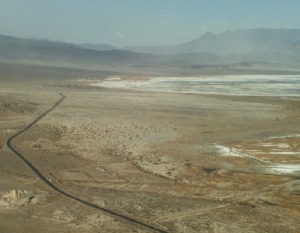Pumping the aquifer under Owens Lake to meet dust mitigation and habitat requirements has been the elephant in the room for a very long time. The question of whether groundwater extraction under the lake is governed by the Long Term Water Agreement or not may never be resolved, but pumping will be a hot topic in the Los Angeles Department of Water and Power’s Environmental Impact Report and eventually managed under the California Environmental Quality Act.
Groundwater rose to the surface of Tuesday’s Board of Supervisors’ discussion of its official comments to the department’s Notice of Preparation. The County’s input included wording almost verbatim from a January 2014 letter from the Water Department to LADWP. Inyo County would agree to disagree with LADWP on the applicability of the LTWA to groundwater pumping under the lakebed, allow pumping, under the restrictions of the EIR, “provided DWP and the County agree that any other groundwater pumping by DWP in Inyo County, whether for the purpose of supplying water for dust control on Owens Lake or for other purposes, would be subject to the Water Agreement.”
Basically, the EIR process, with its monitoring program and other protocol, may make the LTWA question moot with neither side of the dispute claiming victory or conceding defeat.
The County’s comments focused on keeping some of the water saved on the Owens Lake for in-valley uses, land use issues, clarification on actual water savings, and, of course, groundwater pumping. Lone Pine resident Earl Wilson requested the Board include continued participation by the master project working groups and Board Chair Matt Kingsley agreed. “We want to provide input as the project goes farther,” he said, “to continue to engage in conversation as the project changes over time.”
The long history of the pumping/LOTWA dispute is something like a verbal chess game, adrenalin pumping entertainment for policy wonks or lawyers, not so much for normal human beings. An April 2010 letter from the Inyo County Water Department to then Aqueduct Manager Gene Coufal serves as a historical review. In 2006, LADWP “reaffirmed its understanding that the Water Agreement will govern any groundwater pumping to supply dust mitigation measures on Owens Lake,” the letter states.
That understanding took a shift at a February 2010 Standing Committee meeting. LADWP’s argument was its interpretation of the California Health and Safety Code section 42316, covering Great Basin Air Pollution Control District’s mandate to the City to control dust on the dry lake. DWP’s interpretation was that the H&S Code trumped the LTWA, exempting groundwater pumping for dust control from the agreement.
But, the County pointed out, that same code “shall not affect the right of the city to produce, divert, store or convey water” and, therefore, did not exempt pumping from the agreement. According to this 2010 letter, the County wanted to assure “groundwater pumping activities and related impacts should receive the full scrutiny and protection required by the LTWA.”
LADWP’s next move, or letter, cited Section XVIII of the LTWA, “Any project implemented pursuant to California Health and Safety Code 42316 is not part of this Stipulation and Order.” In later communication, the department maintained that while groundwater pumping under the lakebed was not specifically required by Great Basin, it was still exempt under the H&S Code.
The County tried to strike a deal on the dispute in its January 2014 letter; the department has yet to comment.
County Water Department Director Bob Harrington told the Supervisors Tuesday that LADWP had initiated the arbitration process to settle the dispute. “It’s been on the back burner for a few years,” he said. “But could be initiated at any time…. (groundwater pumping) will be resolved in the CEQA process. A good management plan as part of the EIR is what we wanted.”


















Comments are due by 5pm tomorrow Friday Aug 7,2015 from government entities and interested individuals regarding issues and ideas to be addressed in the Owens Lake Master Project Environmental Impact Report . Comments and contributions can be emailed to [email protected] A 12 page Notice of Preparation Letter containing a project… Read more »